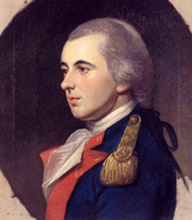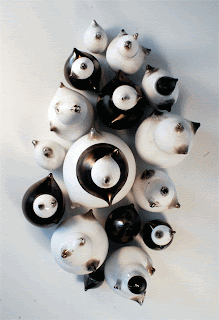>How the Washington Glass School is Tied to the War of 1812, The Brits Sacking the White House & The Star Spangled Banner.
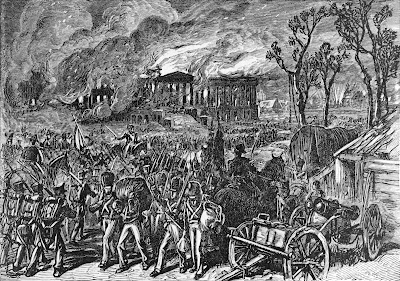 |
| The British burn the President’s Mansion 1814 |
One of the beauties of being in Washington, DC is the sense of history that surrounds the place. Growing up in northwest suburban Chicago, history seemed to have started after WWII, with suburban subdivisions overtaking farmland. Here, the area is so steeped with the history that appears in grade school books, that important – but deemed lesser – sites can be forgotten; the scurf of yesterdays. As the Maryland area celebrates the Bicentennial of the War of 1812, it is interesting to note that the Washington Glass School building sits atop an important battlefield – one of the key parts in the Battle of Bladensburg. With the US loss at this battle, British forces swept into Capitol Hill and burned the White House, the Capitol and the Treasury.
Since there are no signs on the site – this blog will act as a virtual ‘historical marker”.
Historical Overview
The War of 1812 was a military conflict fought between the United States of America and the British Empire. In these battles, the British set off their new weapon – the Congreve rocket – a rocket carrying about one pound of powder that could travel almost 1,000 yards and their success had a tremendous impact on modern warfare.
After the defeat and exile of Napoleon in April 1814, the British were able to send newly available troops and ships to the war with the United States. On August 20, 1814, over 4,500 seasoned British troops landed at the little town of Benedict, MD and marched fifty miles towards Capitol Hill.
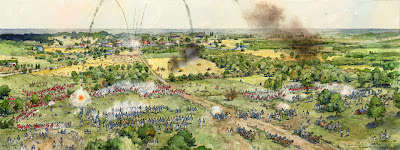 |
Artists Rendering of the Battle of Bladensburg
(Gerry Embleton-Courtesy NPS/Star Spangled Banner National Historic Trail) |
What Went Wrong
Incorrect deductions that were drawn gave the Americans the impression that Baltimore was their destination. General Armstrong could not be convinced that Washington would be the target of the invasion and not Baltimore, an important center of commerce. There was much confusion trying to outguess the British. In Bladensburg, MD, American troops began to be assembled by Brigadier General William Winder, the Secretary of War, John Armstrong, as well as the Secretary of State, James Monroe. General Smith, another American commander, used his aide – Francis Scott Key – to assemble his troops. Calvary units were positioned to the right of the main road (now called Bladensburg Ave.), while the first and second American lines were positioned nearly a 1/2 mile apart from each other. The organization (and constant second guessing by commanders) of the troops, the general concern about the size of the British army, and the lack of preparation by the rag-tag militia would eventually lead to the undoing of the hastily assembled group.
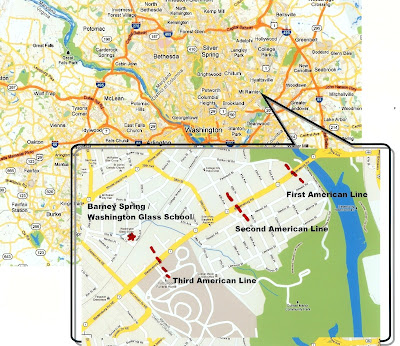 |
| Current day map showing US troop positions in Battle of Bladensburg |
As the British entered the town, they were greeted by the American troops firing the first volleys across the Eastern Branch of the Potomac (now called Anacostia River). The British initially fell back and moved behind the masonry buildings in Bladensburg. Soon though, the British set off their new weapon – the Congreve rocket. These rockets would eventually become the famous “rocket’s red glare.” British troops began to return fire as the rockets burst above the Americans. American leaders on the first line, unclear on their support from the second line, ordered retreat. American soldiers began to fall back and leave the field via the Georgetown Pike (now Bunker Hill Road). The second line, (positioned approximately at the modern 40th – 38th Avenue) and the members of the Cabinet left the field of battle at or before this point. Cannons were left behind, soldiers moved in haphazard movements responding to the need to fight and the orders for retreat. General chaos reigned across the field of battle.
The strongest attack against the British was made by Commodore Joshua Barney and his seasoned Floatillamen. At Dueling Creek, Kramer’s Militia (troops from Montgomery and Prince George’s County) fought hard against the British but eventually retreated up the hill past Commodore Barney’s men. Barney’s men were valiant fighters, however, the authorities in Washington “forgot” Barney for several days. Without orders, he and his men arrived in the midst of the battle. Combined with Captain Miller’s Marines, Barney fired down the hill toward the British, causing significant British casualties. British troops were ordered into a single file line, flanking Barney’s troop placement and overtaking them. Commodore Barney, after having had his horse killed under him in battle, was severely wounded by a musket ball “near a living fountain of water on the estate of the late Mr. Rives, which was later known as Barney’s Spring“Benson Lossing, Field-book of the War 0f 1812, Chapter 39, 1869
General Winder ordered a general retreat. The retreat order was never passed to Barney’s command, but with no ammunition, flanked on the right and deserted on the left, the Commodore knew that the end had come. He ordered the guns spiked and the men to retreat. The officers and men who were able to march effected the retreat; but the Commodore’s wound rendered him unable to move, and he was made prisoner. He died shortly after; but not before he was able to have influence on Francis Scott Key in his efforts to compose the Star Spangled Banner.
The building that houses the Washington Glass School is located on the site (now near the intersection of Oak and Otis Street).
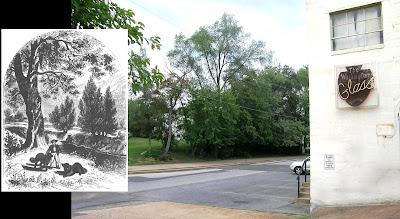 |
Then & Today
Left inset: Engraving (ca. 1860) of battlefield site where Joshua Barney fell by Benson Lossing in “Field Book of the War of 1812 “ ; Right: Washington Glass School on the same site. Over the past 200 years, the topography has been modified and changed tremendously – the creek now flows under the concrete pathway opposite the Glass School. |
Immediately after the battle, the British sent an advance guard of soldiers to Capitol Hill. The President’s house was burned, and the British raised their Union Flag over Washington.
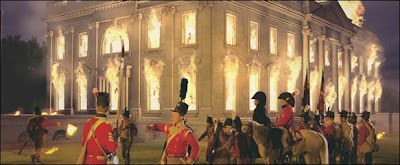 |
| The Brits pillage the White House. |
The First Lady Dolley Madison remained behind to organize the slaves and staff to save valuables from the British. The buildings housing the Senate and House of Representatives were set ablaze not long after. The interiors of both buildings, which held the Library of Congress, were destroyed, although their thick walls and a torrential rainfall that was caused by a hurricane the following day preserved the exteriors.
 |
| During the war of 1812 when the British attacked Washington DC, The First Lady, Dolley Madison stayed behind in the White House to save the artifacts and symbols of America. The engraving above shows her saving the Declaration of Independence. |
With their mission accomplished, the British feared the Americans would reassemble their forces and attack while they were in the vulnerable position of being a long distance from their fleet. The men were miserable in the sweltering temperatures. They were tired, ill and wounded. At dusk the troops quietly withdrew from the city. The troops were so exhausted that many died of fatigue on the four day march back to the ships, several deserted, but the body of men marched on.
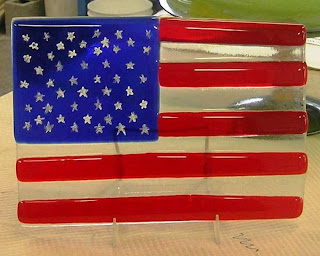
Several of the British stragglers and deserters were arrested by citizens in Maryland. When the British commanders learned of the incident, they sent a small force back to arrest William Beanes, a well respected doctor and town elder. Following his arrest, Georgetown lawyer Francis Scott Key and U.S. Agent for Prisoner Exchange John S. Skinner went to secure Bean’s release from the British. They brought with them letters from British troops who testified as to the compassion that they received while in Bladensburg after the battle. Brought on board one of the British vessels, Francis Scott Key would see the battle in Baltimore raging on and the flag standing at the end of the battle, leading to the writing of the Star Spangled Banner.
Times have changed, and we now rely on the Brits as an important and trusted ally – however -the next time representatives from DC Sister City – Sunderland, England comes for a visit to the Glass School, they have some ‘splaining to do.
For more info – check out the book A Travel Guide to the War of 1812 in the Chesapeake
And also – a link to website that shows the archaeology of the Bladensburg battle site.
Posted in barney's spring, battle of bladensburg, bicentennial, congreve rocket, dolley Madison, francis scott key, joshua barney, rives, star spangled banner, war 1812
>

The Capitol Arts Network (CAN) is a nonprofit Arts Group founded in 2003 to bring arts opportunities and information to the Metro DC area. As it has grown, the organization is now at the point of needing a permanent headquarters.
CAN also acutely aware of the need for artist studio space in the metro DC region and they want to let everyone know that exciting things are happening in their search for a new location for in Montgomery County. The team at Capitol Arts Network has been touring spaces and have narrowed the search to a location that can easily house at least 30 or more working artists, and many more affiliate artists – with gallery, classroom, meeting space and the opportunity for vibrant growth alongside the thriving arts organization.
CAN’s goal is to encourage community building among a wide range of artists and disciplines, and to offer tremendous educational and inspirational opportunities for area artists is well on its way to being realized. A big announcement is coming by the the end of August, and they want everyone aware, as the plans move rapidly forward.
If you are interested in knowing more and want to be in on CAN’s big announcement coming soon, please send and email to Judith HearSong at CAN
and add your contact information. CAN wants everyone to know about the upcoming space – so forward this posting to artists, photographers, and other creative professionals who might be interested in studio space or the opportunity to become an affiliate artist!
Information will be posted on CAN’s website as soon as plans are finalized, and fingers crossed there is great interest from the arts community as this project becomes a reality in a few short months.
email Judith HeartSong at judith@capitolartsnetwork.com
Posted in CAN, capitol arts network, judith HeartSong
>
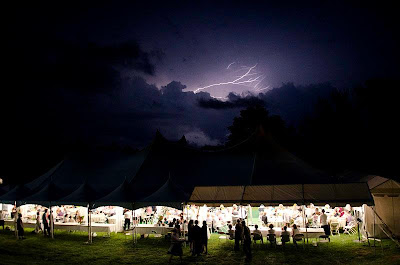 |
| The Penland 2012 auction tent as lighting lights up the sky. The central focus of the trip was built around attending Penland’s Annual Benefit Auction featuring the sale of over 200 craft items, and it was a wonderful opportunity to interact with fellow craft enthusiasts. |
Tim Tate and Sean Hennessey have just returned from taking a James Renwick Alliance (JRA) tour out to North Carolina’s Penland School of Crafts for the Annual Benefit Auction. Additionally, the “Tour with Tate” visited the studios of some of the most talented artists surrounding
Asheville. For this post – we will tag along with the JRA as they visit some of the artist studios.
 |
|
Michael Sherrill’s incredible studio
|
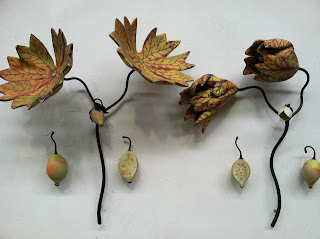 |
| Michael Sherrill’s ceramic artwork |
Ceramist Michael Sherrill has been making pots for more than twenty years. Originally, his work was completely functional, but it has evolved into work that is now wholly sculptural. He is one of the most thoughtful and articulate sculptors of our time.
 |
| Michael Sherrill talking about his work |
Hoss Haley has worked in metal for over twenty years, creating sculpture, paintings, and public art. Hoss’s work is in several collections including Lowes Corporation, McColl Centerfor Visual Art, and the Mint Museum of Craft + Design.
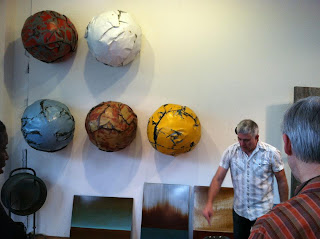 |
| Hoss recycles objects like washing machines and cars – often crumpling them into ball shapes mounted to walls or stacked. |
Christina Cordova & Pablo De Soto’s studio was visited as part of the tour. This husband and wife team operate their amazing studios on the grounds of Penland itself. Pablo’s beautiful glass blown vessels were loved by all and Cristina Cordova’s incredible ceramics were a highlight to the tour.
 |
| Christina Cordova talks about her recent works. |
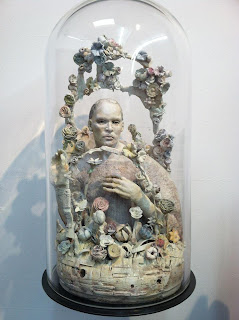 |
| Christina Cordova’s work is awesome. |
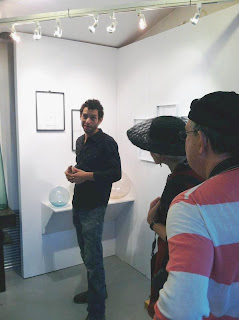 |
| Pablo De Soto charms Fred and Susan Sanders |
A trip to the Asheville Art Museum included a personal tour by curator Nancy Sokolove. Also, glass artist Alex Bernstein came to talk about his process.
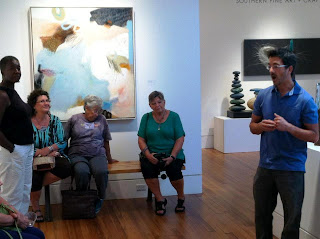 |
| Alex Bernstein talks to the JRA at the Asheville Art Museum. |
Dan Essig’s wordless works of art are sewn, woven and carved into magnificent artists’ books and sculptures. Dan’s works incorporates so many things -fossils, shells, coins and old nails—into his artwork.
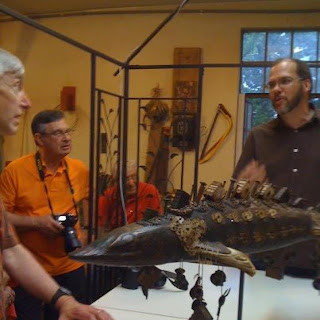 |
| Dan Essig talks of his work |
No trip to Asheville would be complete without a visit to the famous Blue Spiral Gallery. This amazing gallery currently has up work from the “Glass Secession” exhibit – that includes works by Christina Bothwell, Tim Tate, Michael Janis, Susan Taylor Glasgow and Sean Hennessey.
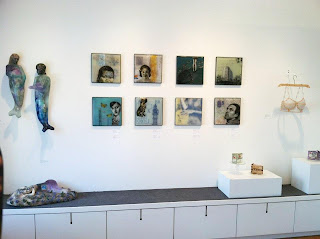 |
| A view of the Blue Spiral 1 Gallery. |
Stoney Lamar works in sculptural woodturning. His work is in such collections as High Museum of Art (Atlanta), American Craft Museum (NY), Renwick Gallery, Smithsonian Institute, Yale University Gallery of Art, Mint Museumof Craft & Design (NC), Minneapolis Institute of Art, Wustum Museum of Fine Arts and the Detroit Institute of Art.
 |
| Stoney shows some of the special woods that Fleur Bresler had sourced. |
 |
| Stoney talked of his process to the tour. |
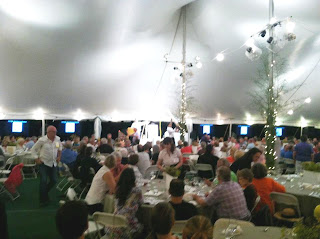 |
| The big show was the drama, anticipation and socializing at the Penland Auction. |
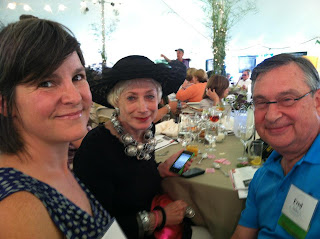 |
| Glass sculptor Beth Lipman chats with Susan and Fred Sanders |
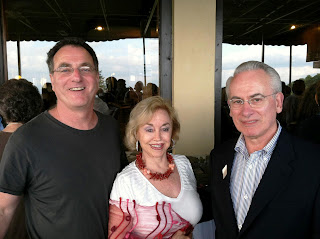
Dan Clayman with the proud owners of his Penland auction piece….Giselle and Ben Huberman
The annual Penland auction was huge success. Over 600k raised for an incredible place – a new record! Congrats to all who were involved!
Posted in auction, blue spiral gallery, christina cordova, dan essig, fred sanders, hoss haley, huberman, james renwick alliance, JRA, penland school of craft, sean hennessey, susan sanders, Tim Tate
>
Novie Trump is a world renown ceramic artist, working from Flux Studios, located right next door to the Washington Glass School. Her poetic sculptural work often involves depictions of nature – presented in unexpected and captivating ways.
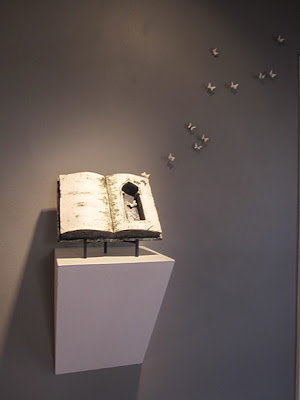 |
Novie Trump Escape Installation of porcelain butterflies and ceramic book
Ceramic, Acrylic Rods, Steel 60” x 60” x 24”(variable) |
Novie is working on a commissioned artwork piece that came to her via Project 4 Gallery: to create large scale installation that will be located in the new Farmers & Fishers restaurant now being built at the Georgetown waterfront.
Her artwork design calls for many porcelain bees to be clustered around illuminated hives are various locations. The design of the beehive has brought her to the glass studio – and it is a chance for the glass artists to bring Novie over to the dark – or rather – the glassy side.
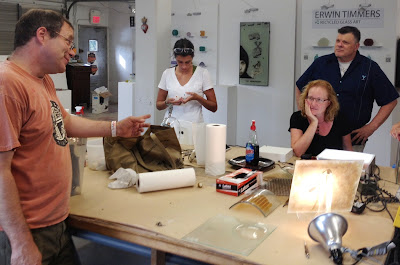 |
| Erwin Timmers offers some adventurous suggestions to Novie, but from the expressions on both her and Tim Tate’s face, they seem unlikely to be incorporated. |
 |
| A sample of Novie Trump’s porcelain bees |
Novie chose to work with illuminated glass – creating a pattern of cellular hive divisions with frit powder fused to glass, and slumped over a tapered form. The WGS fritmaster – Michael Janis – offered Novie some pointers on how to manipulate the powder.
 |
| Novie Trump and Michael Janis share a laugh as they work |
 |
| Novie sifts glass powder onto a sheet of glass |
 |
| Manipulating frit powder is a delicate operation |
 |
| Novie Trump and Michael Janis evaluate the glass’ progress prior to loading the layer in a kiln for firing |
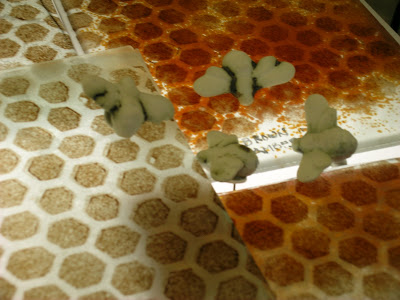
After fusing, the samples are compared by Novie Trump for her preferred selection of color and texture combination |
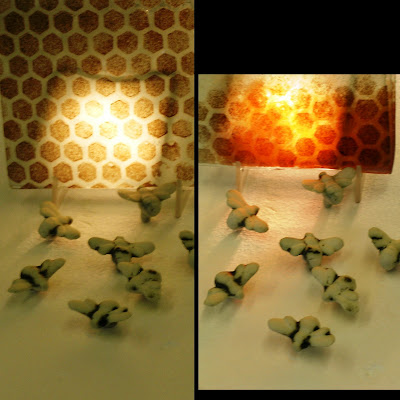 |
| Novie made many studies of the color and textures and tested the samples with light source alternates. |
The glass will later be slumped and a housing for the lighting made in the glass school’s welding shop. Novie will be making the rest of her porcelain swarms and fusing the glass in the next few months, and she promises to send us photos of the finished work.
Posted in crossover medium, flux studios, glass and ceramic, light sculpture, michael janis, novie trump, porcelain, project 4 gallery, scraffito, sgraffitto
>
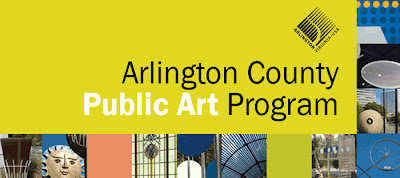
Public Art Evaluation: Principles & Methodology for Measuring Social Impact
Arlington Public Art Administrator Angela Adams will be a presenter on the upcoming Americans for the Arts Webinar: “Public Art Evaluation: Principles & Methodology for Measuring Social Impact” August 16, 2012 at 2:00 p.m. EDT (60 minutes).
When public art administrators are asked to make the case for their program, it is beneficial for them to look at both the economic and social impact of the artworks within the larger urban, social and cultural context. Is there a reliable framework that can be the basis of good public art evaluation? And what are some simple yet effective evaluation methods that public art programs can implement? These questions and more will be addressed in Americans for the Arts’ ongoing work in measuring the impact of public art.
This webinar will be presented by recent PAN and Animating Democracy Blog Salon contributors Dr. Elizabeth Morton, Professor in Practice, Urban Affairs and Planning, Virginia Tech, Alexandria campus; Angela Adams, Public Art Administrator, Arlington Cultural Affairs, Arlington, VA and Katherine Gressel, artist and Programs Manager at Smack Mellon Gallery (NY); Pam Korza, Co-Director Animating Democracy, Americans for the Arts.
To sign up for the webinar, register on the Americans for the Arts Website or read Angela’s recent blog post on evaluation on the ARTSBlog.
Date: Thursday, August 16, 2012
Time: 2:00 – 3:00 p.m.
Place: Webinar
Registration:
Register Online
Fee: Free for
Americans for theArts Members
Posted in americans for the arts, angela adams, arlington public art
>

A new lampworking studio has opened in NoVa – the Heat Base. Located in suburban Woodbridge,Va. just off I-95 (near Potomac Mills).
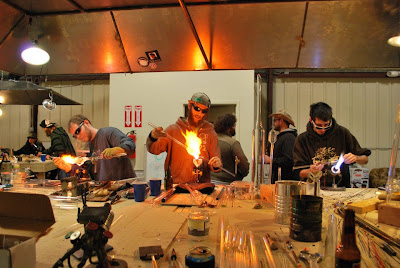
They offer some group class and private lessons.
For more info Contact Robert Kincheloe
email : robert@brvglass.com
Look them up on Facebook
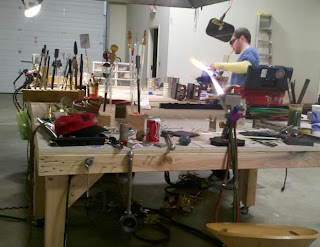
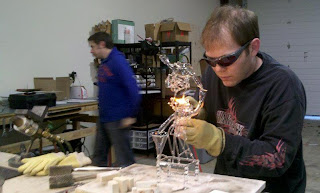
The Heat Base
13876 Dawson Beach Rd
Woodbridge, Virginia 22191
Posted in brv glass, lampworking, robert kincheloe, torchwork
>
 27th Penland Schoolof Crafts Annual Benefit Auction
27th Penland Schoolof Crafts Annual Benefit Auction
August 10 – 11, 2012
Penland School of Craft is a national center for craft education dedicated to helping people live creative lives. Located in the Blue Ridge Mountains of North Carolina, Penland offers one-, two-, and eight-week workshops in books & paper, clay, drawing, glass, iron, metals, photography, printmaking and letterpress, textiles, and wood. The school also offers artists’ residencies, community collaboration programs, and a gallery and information center.
The Penland School of Crafts Annual Benefit Auction has their gala weekend in the Carolina Mountainsfeaturing the sale of 237 works in books, clay, drawing, glass, iron, letterpress, metals, painting, photography, printmaking, textiles, and wood.

The Penland auction is one of the most important craft collecting events in the American Southeast and is the perfect opportunity to support Penland’s educational programs, which have helped thousands of people live creative lives.

If you cannot make it out to the mountains of North Carolina – you can participate in the auction online:
Catalog
Click the link below to download an illustrated catalog of artists and work in this year’s auction:











